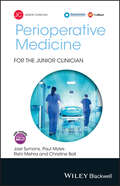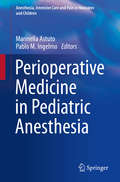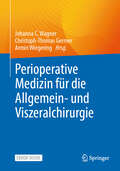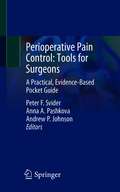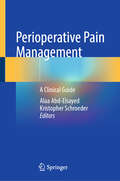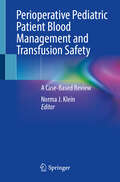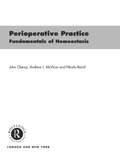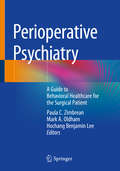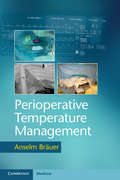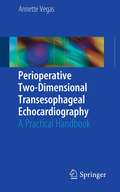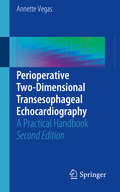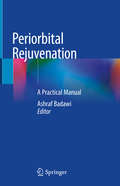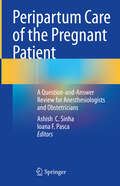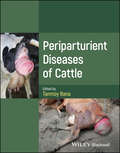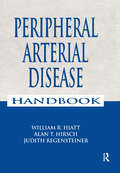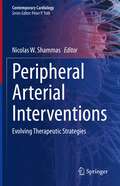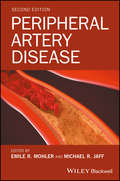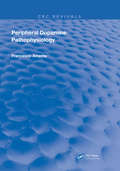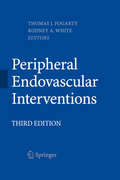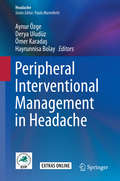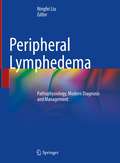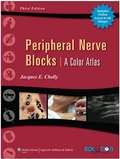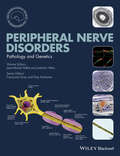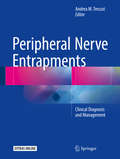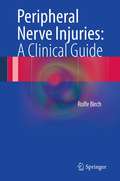- Table View
- List View
Perioperative Medicine for the Junior Clinician
by Paul Myles Christine Ball Rishi Mehra Joel SymonsPerioperative Medicine for the Junior Clinician is the first easy-to-read resource, featuring a digital component, on how to manage a diverse range of patients in the perioperative period, providing up-to-date practical knowledge and advice from a broad range of medical specialists caring for surgical patients. Perioperative Medicine for the Junior Clinician provides a guide to perioperative care, covering principles and practices of care; risk assessment; laboratory investigations; medication management; specific medical conditions and complications; postoperative care and pain management. It also features bite-size videos explaining the key concepts, as well as case studies, investigations and quizzes. Ideal for final year medical students and junior clinicians, this digital and print resource will be an invaluable tool when working in this multidisciplinary, team-based specialty. Perioperative Medicine for the Junior Clinician: Is based on a sell-out course run at the Alfred Hospital and Monash University in Melbourne, Australia Is a practical resource available in a flexible and portable content Features bite-size videos which further explain concepts in the written text, and clinically relevant case studies, all found on the companion website Is structured around guidelines and protocols The video materials, case studies, self-assessment quizzes and fully explained answers can be viewed on the companion website at www. wiley. com/go/perioperativemed
Perioperative Medicine in Pediatric Anesthesia
by Marinella Astuto Pablo M IngelmoThis book provides a comprehensive overview of current practices in pediatric perioperative care. Current knowledge on vascular and nonvascular access, regional anesthesia, and noninvasive cardiovascular and respiratory monitoring is described. The prevention and treatment of postoperative pain and unsettled behavior after surgery, as well as the long-term consequences of anesthesia and surgery are discussed. Prevention of chronic postsurgical pain and the brain damage that may be associated with anesthesia and surgery are also considered. The opening section is dedicated to patient care prior to surgery and includes preoperative assessment and preparation. Care in the intraoperative period is then described, including the appropriate care when performing surgery in different locations and in various specialties, such as orthopedic surgery, neurosurgery, thoracic surgery, and abdominal and urological surgery. The subsequent section addresses perioperative care in children with special conditions, such as difficult airway, metabolic or neuromuscular diseases, or cancer. The remainder of the book is devoted to a range of further important topics and postoperative care. &nbs p;
Perioperative Medizin für die Allgemein- und Viszeralchirurgie
by Christoph-Thomas Germer Armin Wiegering Johanna C. WagnerFür den Behandlungserfolg in der Allgemein- und Viszeralchirurgie stellt die Betreuung der Patientinnen und Patienten auf der Station und in der Ambulanz einen zentralen Pfeiler dar. Alle Facetten der perioperativen Medizin sind in diesem Buch fundiert und praxisorientiert beschrieben, von der Risikoevaluation bis zum Umgang mit postoperativen Problemen, die nach spezifischen Eingriffen auftreten können. Aus dem Expertenwissen und der klinischen Erfahrung der Autorinnen und Autoren sowie der einschlägigen Literatur lassen sich konkrete Handlungsempfehlungen auch für spezielle Fragestellungen ableiten.
Perioperative Pain Control: A Practical, Evidence-Based Pocket Guide
by Andrew P. Johnson Peter F. Svider Anna A. PashkovaAccording to the Centers for Disease Control and Prevention (CDC), there were nearly 40,000 opioid-related deaths in the U.S in the last year alone. These numbers have increased considerably for a variety of reasons, and the growing role of prescription drug abuse has been widely recognized. There has also been increasing consciousness of the lack of dedicated and formalized training dedicated to prescription of analgesics, particularly among surgical trainees and practicing surgeons. Recent studies demonstrate that only a small minority of training programs mandates any opioid prescribing education, despite the fact that nearly all programs allow trainee prescription of opioids on an outpatient basis. Therefore, it is not surprising that despite a growing body of literature illustrating the value of opioid alternatives and adjuncts, practicing surgeons in all specialties largely ignore these evidence-based practices and continue to prescribe opioids in situations for which alternatives are proven, safe, and effective. There are many reasons for preparing a concise and practical resource describing evidence-based practices targeting surgeons and surgical subspecialists, including but not limited to: (1) The exponential increase in prescription drug abuse associated with the “opioid epidemic,” as surgeons play an important role in managing perioperative and chronic pain in a variety of practice setting; this issue bears importance from the patient, physician, and policymaker standpoint; (2) With increasing recognition of the role of quality improvement in patient safety initiatives, and literature demonstrating inadequate opioid prescribing education (OPE) in surgical training programs, it is only a matter of time before accreditation bodies including the ACGME incorporate strong recommendations and mandates for OPE; (3) Myriad literature demonstrating the existence of evidence-based alternatives to opioids – All surgeons and surgical subspecialists would benefit from a practical guide concisely laying this literature out. We feel that surgeons of all experience levels may benefit, ranging from the first year surgical intern to an experienced practitioner trying to remain compliant with the evolving opioid regulatory environment.Hence, the appropriate target audience for this text would be for the tens of thousands of current surgical trainees in many specialties, including general surgery, thoracic surgery, otolaryngology, plastic surgery, urology, gynecology, vascular surgery, neurosurgery, and orthopedic surgery. Furthermore, surgeons out of training would be another audience of interest, as there are increasing courses for continuing medical education based on perioperative and chronic pain management. Currently, there are no comparable and competitive guides with these target audiences; all of the existing literature about perioperative and chronic pain is targeted either specifically for patients, anesthesiologists, or pain medicine physicians. This will be the only up to date guide focusing on evidence-based practices for perioperative pain control, and each section will also include information on chronic pain sequelae relevant to each surgical specialty. The editors envision this text being an interdisciplinary endeavor, incorporating surgeons from multiple specialties, anesthesiologists, pain medicine physicians, and palliative physicians as appropriate.
Perioperative Pain Management: A Clinical Guide
by Alaa Abd-Elsayed Kristopher SchroederPerioperative Pain Management: A Clinical Guide provides a unique and comprehensive approach to pain management, offering effective treatment strategies tailored to various specialties. This collaborative effort includes insights from experts in anesthesiology, pain management, physical medicine, addiction medicine, pharmacy, and surgery, ensuring diverse and inclusive content for all healthcare professionals involved in perioperative pain management. The book addresses special patient populations, highlighting specific challenges and strategies to meet their analgesic needs. Clinical providers seeking a blueprint for creating optimal perioperative pain management pathways will find this guide invaluable for planning and optimizing their clinical resources.
Perioperative Pediatric Patient Blood Management and Transfusion Safety: A Case-Based Review
by Norma J. KleinThis case-based book is focused on perioperative pediatric PBM and blood transfusion safety, while addressing a number of patient management issues. Divided into three sections covering all phases of perioperative care, each chapter consists of a stem question, followed by an analysis of the issue, then a discussion of the current evidence in the literature. Rather than being a transfusion-related book written by pathologists and laboratory specialists, chapters are authored by highly specialized clinicians who will write from first-hand experience in addition to an exploration of the current literature. The book features management summaries of topics with scant or only recently available evidence and offers novel content and format in the pediatric patient literature. Perioperative Pediatric Patient Blood Management and Transfusion Safety is an informative guide for any clinician that treats a child before, during, or after a blood loss surgery.
Perioperative Practice: Fundamentals of Homeostasis
by Nicola Baird John Clancy Andrew McVicarWritten by experienced nurse lecturers and a theatre nurse, Perioperative Practice highlights and explains the biological processes which can be disrupted by a major surgical procedure. Using the concept of homeostasis as a framework, the authors look at issues common to all surgical procedures such as the influence of anaesthesia on the nervous system or perioperative pain management. Individual chapters cover: the human body and principles of homeostasis the surgical approach and endoscopic procedures perioperative influences on body fluid homeostasis perioperative influences on immunological homeostasis and wound healing perioperative influences on cardiovascular homeostasis perioperative influences on respiratory homeostasis anaesthesia, stress and surgery pain and pain relief in the perioperative patient. Generously illustrated in colour and black and white, the text features further learning activities and useful summaries of key points. It provides an important resource and supporting text for all nurses undertaking courses in theatre work or related areas or already working in such areas.
Perioperative Psychiatry: A Guide To Behavioral Healthcare For The Surgical Patient
by Paula C. Zimbrean Mark A. Oldham Hochang Benjamin LeeThis book provides a comprehensive review of mental health topics for pre- and postsurgical patients. The book discusses general aspects of psychiatric care during the immediate pre- and postsurgical phase, such as pain management, psychopharmacological management or legal aspects of informed consent. The volume dedicates one section to specific subspecialties, including cardiac surgery, neurosurgery, organ transplantation, plastic surgery, bariatric surgery, and many others. Each of these chapters address preoperative psychiatric risk factors, evaluations, impact, and management recommendations for prevention and treatment of the most common psychiatric complications. The final section reviews the current dilemmas and questions for future research in this field, including delirium and capacity evaluation. The text concludes with commentary written by experts in the fields of consultation-liaison psychiatry and surgery on future directions and considerations. Perioperative Psychiatry is a valuable resource for psychiatrists, psychologists, surgeons, trainees, nurses, social workers, and all medical professionals concerned with the behavioral health of surgical patients.
Perioperative Temperature Management
by Anselm BräuerThis practical text offers a comprehensive guide to perioperative temperature management for anaesthetists, surgeons and nurses. The physiological basics of thermoregulation and heat exchange are covered, before the changes that occur during general and regional anaesthesia are outlined. The relevant adverse scenarios associated with perioperative hypothermia, including morbid cardiac events, impairment of coagulation, increased blood loss and surgical site infections are discussed, before the methods of measuring core temperature and the equipment and techniques to keep patients warm are described. Richly illustrated and clearly structured for quick reference, Perioperative Temperature Management is an essential daily resource to help ensure safe, effective practice. The first book to focus specifically on perioperative temperature management, and therefore the 'go-to' resource on the subject. The book will enable readers to understand the subject from the physiological basics through to the use of warming therapy. Extensive illustrations help the reader to understand the changes in core temperature immediately before, during and after the operation.
Perioperative Two-Dimensional Transesophageal Echocardiography
by Annette VegasTransesophageal echocardiography (TEE) is a valuable diagnostic modality now routinely used during cardiac surgery and in the intensive care unit. Increasingly, anesthesiologists trained in TEE provide the service in both settings where they face the challenge of integrating numerous current TEE guidelines into day-to-day practice. Perioperative Two-Dimensional Transesophageal Echocardiography: A Practical Handbook has been designed to be a concise, portable guide for using TEE to recognize cardiac pathology during the perioperative period. This compact guide has a diverse appeal for anesthesiologists, cardiac surgeons, and cardiologists desiring comprehensive up-to-date echocardiographic information at their fingertips. Features More than 450 full-color, high quality clinical images and illustrationsSynopsis of cardiac pathology commonly encountered in cardiac surgery patientsConvenient spiral bindingOn-the-spot reference for echocardiographers with a wide range of experience, from novice to expert
Perioperative Two-Dimensional Transesophageal Echocardiography: A Practical Handbook
by Annette VegasTransesophageal echocardiography (TEE) is a valuable diagnostic modality now routinely used during cardiac surgery and in the intensive care unit. Increasingly, anesthesiologists, cardiologists and critical care physicians trained in TEE provide the service in both settings where they face the challenge of integrating numerous current TEE guidelines into day-to-day practice. Perioperative Two-Dimensional Transesophageal Echocardiography: A Practical Handbook, 2nd Edition has been designed to be a concise, portable guide for using TEE to recognize cardiac pathology during the perioperative period. This compact guide has a diverse appeal for anesthesiologists, cardiac surgeons and cardiologists desiring comprehensive up-to-date echocardiographic information at their fingertips.Features Updated to include 4 new chapters Now contains more than 600 full-color, high quality clinical images and illustrations Includes the most recent guidelines Retains a compact format that highlights key information Synopsis of cardiac pathology commonly encountered in cardiac surgery patients On-the-spot reference for echocardiographers with a wide range from novice to expert experience
Periorbital Rejuvenation: A Practical Manual
by Ashraf BadawiThis title represents a comprehensive manual of periorbital rejuvenation and includes an in-depth review of the anatomy of the orbit and periorbital region. Physiological changes associated with the aging of the periorbital region and potential rejuvenation options are also covered, while readers are given a series of step-by-step illustrative guides to procedural techniques. The book provides a valuable selection of clinical pearls on how to avoid potential pitfalls using a number of cases in which a range of potential invasive and non-invasive treatment options, including neuromodulators and cosmeceuticals, are used. Periorbital Rejuvenation: A Practical Manual provides a comprehensive and concise overview of periorbital anatomy and the potential effects of aging. Cutting-edge laser treatment options including laser assisted and neuromodulator techniques are ideal for the trainee to develop their knowledge and as a reference guide for the experienced practitioner.
Peripartum Care of the Pregnant Patient: A Question-and-Answer Review for Anesthesiologists and Obstetricians
by Ashish C. Sinha Ioana F. PascaAre you an anesthesiologist or obstetrician navigating the complex landscape of peripartum care? The intricacies of managing pregnant patients during the critical peripartum period are covered in this concise and practical question-and-answer review. This book promotes learning evidence-based current knowledge on the clinical aspects of the obstetric parturient from the standpoint of anesthesiology, obstetrics, surgery, pediatrics, and public health. Each topic is initiated with several multiple-choice questions, mimicking the ABA and other board certification exams. Chapters are authored by contributors from multiple specialties offering their expert guidance based on evidence-based guidelines as well as their clinical experience. Key Topics Covered: Cardiovascular Considerations: Understand the hemodynamic changes specific to pregnancy and how they impact anesthesia and obstetric management. Learn to predict which cardiac lesions may lead to peripartum hemodynamic compromise. Hypertensive Disorders: Explore evidence-based strategies for managing hypertensive disorders of pregnancy during the peripartum and postpartum phases. Critical Illness: Discover expert insights on handling critical illness in pregnant patients, including considerations for acute respiratory failure and other emergencies. Neuraxial and Other Anesthesia Techniques: Topics covered include neuraxial anesthesia, inotrope and vasopressor support, and echocardiography. Learn when advanced critical care support is warranted. Whether you’re a seasoned practitioner or a trainee, Peripartum Care of the Pregnant Patient equips you with practical answers to real-world challenges. Enhance your peripartum care knowledge to add to the well-being of your pregnant patient.
Periparturient Diseases of Cattle
by M. V. Sc Tanmoy RanaManage the health of cattle at a critical stage with this essential reference Milk is one of the backbones of the global food economy, with its high vitamin content and key contribution to bone health. As a result, dairy farming is one of the most essential sectors of the global agricultural market, and the health of cattle is an issue of global importance. Periparturient diseases, those sustained in the period immediately before, during, and after giving birth, have a potentially devastating impact on the reproductive cycle of cattle, and an understanding of these conditions is a critical aspect of food production. Periparturient Diseases of Cattle offers a comprehensive overview of these diseases, their pathogenesis, and their treatments. Summarizing all of the major periparturient disorders, their etiology, and their management, it is a critical resource for veterinary practitioners and others for whom cattle health is of fundamental importance. As a reference, a diagnostic aid, and a tool in farm management, this volume is indispensable. Periparturient Diseases of Cattle readers will also find: In-depth description of disease advancement Detailed treatment of disorders including metritis, mastitis, ketosis, and many more Color figures and line drawings to illustrate key concepts Periparturient Diseases of Cattle is ideal for student and working veterinarians, academicians, farm managers, industrialists, farm owners, and many more.
Peripheral Arterial Disease Handbook
by William R. Hiatt Alan T. Hirsch Judith RegensteinerApproximately eight to twelve million individuals in the United States are affected by peripheral arterial disease (PAD). With 200 tables and illustrations and a single focus on peripheral arterial disease (PAD) rather than all vascular disorders, this Handbook is the ultimate clinical care primer for those who seek the most up-to-date and practical PAD clinical strategies. Comprehensive and easy-to-use, the book presents epidemiological and pathophysiological data in succinct format and includes a unique compendium of evidenced-based and expert approaches for the diagnosis and treatment of peripheral arterial diseases. The diagnostic and treatment algorithms are derived from the experience of national experts, and should provide guidance to both trainees and practicing clinicians.
Peripheral Arterial Interventions: Evolving Therapeutic Strategies (Contemporary Cardiology)
by Nicolas W. ShammasThis book examines new technologies (device and pharmacologic) that have evolved over the past few years in treating peripheral arterial disease. Chapters offer optimal strategies to treat PAD, supported by peer-reviewed data. The pillars of this strategy will focus on (a) changing vessel compliance to allow better lumen expansion, (b) less recoil and dissections, and (c) less bailout stenting. Chapters also review embolic protection devices and apply the adjunctive use of anti-proliferative therapy to maintain good long term outcomes. In addition, the book reviews drug coated balloons and drug eluting stent technologies and other means of drug delivery into the vessel wall. The goal of this book is to discuss all these emerging technologies under the strategy of treating patients with the focus on both acute and long term outcomes. Featuring world renown experts, this book offers a critical and comprehensive overview of the current data and future directions that would pave the way for optimal PAD management.Peripheral Arterial Interventions is an essential resource for physicians, residents, fellows, and medical students in cardiology, radiology, vascular surgery, primary care, and health promotion and disease prevention as well as internal and vascular medicine specialists.
Peripheral Artery Disease
by Michael R. Jaff Emile R. MohlerRegenerative Medicine for Peripheral Artery Disease is a comprehensive and up-to-date resource on the use of regenerative medicine for the treatment of peripheral arterial disease. This reference includes a general overview of regenerative medicine and covers important vascular topics, including intermittent claudication and critical limb ischemia, with important mechanisms clearly presented in full color images throughout the book. This important reference includes clear and concise information on both human clinical trials, as well as important and pertinent animal studies, and is a must-have reference for researchers and practitioners of peripheral artery disease. Compiles and explains the rationale and history of different regenerative treatment concepts for peripheral artery disease in one reference Presents pertinent animal studies and human clinical trials in the area of regenerative medicine for peripheral arterial disease, addressing both safety and efficacy of the clinical trials Provides full-color images that demonstrate covered mechanisms Includes access to a full-color website for further study
Peripheral Dopamine Pathophysiology (Routledge Revivals)
by Francesco AmentaFirst Published in 1989, this book offers a full, comprehensive guide into the role of Dopamine in the Periphery. Carefully compiled and filled with a vast repertoire of notes, diagrams, and references this book serves as a useful reference for Students of Medicine, and other practitioners in their respective fields.
Peripheral Endovascular Interventions
by Rodney A. White Thomas J. FogartyThis book offers a comprehensive review of the rapidly advancing field of endovascular therapy, written by internationally recognized authorities in the field, many of whom are the innovators of the techniques and devices involved. Broad in scope, topics covered range from how to obtain training in approved endovascular techniques to promising new lines of investigational therapies.
Peripheral Interventional Management in Headache (Headache)
by Aynur Özge Derya Uludüz Ömer Karadaş Hayrunnisa BolayThis book discusses interventional treatment options on intractable (drug resistant) headache patients and extended headache attacks and extensively reviews the reasons behind treatment failure in intractable headaches, offering potential solutions based on clinical black holes of headache outpatient practice. The most appropriate interventions for certain types of headache such as chronic migraine and medication-overuse headaches, are discussed among others.The book provides practical advice on properly administering the interventional treatments either as a bridge treatments or prophylaxis options. The expected complications of the treatments, and strategies to minimize them are also discussed. Approaches in special patient populations such as pediatric or pregnancy cases and other non-standard cases are also extensively discussed.
Peripheral Lymphedema: Pathophysiology, Modern Diagnosis and Management
by Ningfei LiuThis book provides extensive knowledge of peripheral lymphedema, including the etiology and pathophysiology of the disease, as well as the anatomy and physiology of the lymphatic system and guide for the treatment of lymphedema to clinicians. The ultimate goal of lymphedema therapy is the targeted and individualized treatment. New technology of multimodality lymphatic imaging emerged in the recent years largely improves the diagnosis of lymphatic circulation disorders. The treatment of peripheral lymphedema is expected to have new achievement. This book illustrates the latest achievements in clinical and basic research of lymphedema to the clinical investigators as well as basic researchers. Pathogenesis of lymphatic system, diagnosis of lymphedema, treatment and further complication management are demonstrated in this book. Some special lymphedema related syndromes, issues on prevention and prognosis are also included.
Peripheral Nerve Blocks: A Color Atlas (3rd Edition)
by Jacques E. ChellyThoroughly updated for its Third Edition, this best-selling full-color atlas is a step-by-step guide to performing more than 60 peripheral nerve blocks, including those used in children. For each nerve block, the book provides detailed information about indications, patient positioning, needle size, drug selection, volume for infusion rate, anatomic landmarks, approach, and technique and offers tips for maximizing effectiveness and minimizing complications. Full-color clinical photographs and line art demonstrate anatomic landmarks, patient positioning, and techniques. This edition offers new material on ultrasound guidance and continuous catheter techniques.
Peripheral Nerve Disorders: Pathology and Genetics
by Joachim Weis Jean-Michel VallatPeripheral Nerve Disorders: Pathology and Genetics is a definitive, clinically-oriented guide to the pathology of peripheral nerve disorders. <P><P> These commonly seen neurological challenges have many causes and accurate diagnosis is often necessary via pathological analysis. New techniques exploiting molecular biological knowledge have opened up new vistas to understanding the pathogenesis of these disorders, and hence their effective management. This new title takes a disease-oriented approach to understanding the pathology of these conditions. It combines classical and contemporary techniques to enable practitioners in neurology and neuropathology to better understanding of the disease processes underlying patients' presentations and to formulate appropriate management plans. Peripheral Nerve Disorders: Pathology and Genetics is a valuable resource for neurologists, neuropathologists, pathologists, neurobiologists and geneticists.
Peripheral Nerve Entrapments
by Andrea M Trescot Abipp FippFeatured as a single volume, this is a comprehensive guide to possible nerve entrapment syndromes and their management. Each chapter covers a single nerve, or group of closely related nerves, and goes over the clinical presentation, anatomy, physical exam, differential diagnosis, contributing factors, injection techniques, neurolytic/surgical techniques, treatments of perpetuating factors, and complications. Nerve entrapments can occur throughout the body and cause headaches, chest pain, abdominal pain, pelvic pain, low back pain, and upper and lower extremity pain. As an example, one of the most common forms of nerve entrapment syndrome, Carpal Tunnel Syndrome, affects roughly 1 in 20 people in the United States, and is only one of several types of entrapment syndromes possible for the median nerve. Chapters are also extensively illustrated and include 3D anatomical images. The additional online material enhances the book with more than 50 videos - at least 2 for each nerve. This enables readers to easily navigate the book. In addition to a conventional index it includes a "Pain Problems Index" for searching by symptom. Peripheral Nerve Entrapments: Clinical Diagnosis and Management is a long-needed resource for pain physicians, emergency room physicians, and neurologists.
Peripheral Nerve Injuries: A Clinical Guide
by Rolfe BirchPeripheral Nerve Injuries: A Clinical Guide is a fully illustrated and informative reference on injuries within the peripheral nervous system. It incorporates new knowledge in molecular and cellular events which underlie the response of nerves to injury, regeneration and neuropathic pain. Written by a leading expert in the field, Peripheral Nerve Injuries: A Clinical Guide, is a valuable resource for surgeons in residence and training.
